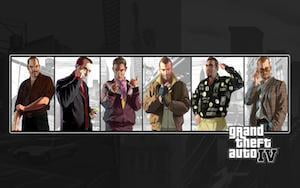How Grand Theft Auto's Gameplay Has Changed Gaming forever! GTA

One title. Three words. 16 sequels. Over 350 million units sold. “Grand Theft Auto” has risen from relative obscurity to earn a spot on the Mt. Olympus of great game franchises. 2022 marked the 25th anniversary of the year “Grand Theft Auto” was released.
Believe it or not, back in 1997 there was no fanfare, no stampede to Circuit City or a Virgin Megastore or whatever now-defunct retailer sold the title. It was just a “cult” hit—but one that would go on to revolutionize video games.
So here’s looking at the humble beginnings of this cultural landmark
Through to its current success, and why it’s just as crucial to gaming now as it was then.
Really, it’s no surprise that “Grand Theft Auto” was a slow burn. It was originally only released for MS-DOS before being ported to Windows and, eventually, the Sony PlayStation. The graphics were crude, and the sandbox level design was about on par with environments seen in ‘80s portable video games. Comparing the later games in the series with the first is like comparing a neighborhood go-kart race to a Formula 1 Grand Prix. It’s that stark a difference.
Still, despite Grand Theft Auto’s aesthetic drawbacks
There was one theme that drew gamers in and has continued to do so over the last two decades: unfettered violence. It was a new angle on the action/crime genre, one that gave players the ability to take their ID out for a walk and let it rampage. All the hallmarks of Grand Theft Auto’s renowned violence and gameplay were on hand in this first iteration: jacking cars, in-vehicle radio stations, a robust armory of firearms, a phone-based mission system, and pillaging environments at will.
Most notably, “Grand Theft Auto” featured three primary locations, all of which would become individual settings for future games: Liberty City (based on New York), Vice City (based on Miami), and San Andreas (a Frankenstein of locales in California and Nevada).
City (based on New York), Vice City (based on Miami), and San Andreas (a Frankenstein of locales in California and Nevada).
Because there was no great fanfare or marketing push
On Grand Theft Auto’s initial release (not like today, anyway), that means gamers had to discover the title. Looking back, the comparatively paltry sales are irrelevant, as the four years between Grand Theft Auto 1 and Grand Theft Auto III allowed the franchise to develop something far more valuable in the long term than quick sales: underground credibility.
It earned a reputation as “that game” some kids had played, but all wanted to play. By the time Grand Theft Auto III rolled around in 2001, gamers’ appetites had been whetted, but even the most hardcore fans of the original couldn’t predict the revolution about to take place.
When Grand Theft Auto III hit shelves, Rock star had Arrived
The company took full advantage of the PS2 engine to deliver the first 3D game in the series. And by eschewing the sandbox setup for a third-person open-world environment, this sequel offered a full-immersion experience, parachuting gamers into a Liberty City where anything goes, controlled by mobsters and populated with pimps, hookers, dealers, tweekers, and every unsavory character under the sun.
Every factor was top-notch, from the game mechanics and sound design to the characters and voice acting. Not surprisingly, “Grand Theft Auto III” won many year-end awards and is still considered one of the most important releases of the 6th-generation console revolution, as well as one of the greatest video games of all time. To date, it has sold over 16 million copies.
With Grand Theft Auto III, Rock star earned a Reputation
As a fan-friendly studio amenable to taking risks, and they solidified this with the 2002 sequel “Grand Theft Auto Vice City,” a hilarious riff on “Miami Vice” and “Scarface” that gave players even bigger environments to explore, all awash in bright pastel and neon-colored lights. Aside from consistently expanding on already stellar gameplay, Rockstar maintained the same high standards for their character development, music soundtracks and voice work.
This was on full display in the subsequent sequels “Grand Theft Auto San Andreas,” which featured loveable thug protagonist CJ, with his customizable physique, and Eastern European immigrant Niko leading us through a revamped Grand Theft Auto Liberty City in “Grand Theft Auto IV,” as well as the return to San Andreas in “Grand Theft Auto V.”
Just as Grand Theft Auto’s sterling reputation
Followed it from sequel to sequel, so too did controversy. “Grand Theft Auto” caused a small uproar upon its release in 1997 due in part to the “cop killing” aspect of the game, and 2001’s “Grand Theft Auto III” was banned in Australia. “Vice City” also ruffled feathers for, among other things, the in-game ability to pickup prostitutes. (Not sure if moral crusaders thought this was better or worse than stomping a digital prostitute to death in the middle of a city street).
By the  time “Grand Theft Auto V” was released, the conversation had shifted (slightly) away from gratuitous violence to misogyny in video games.
time “Grand Theft Auto V” was released, the conversation had shifted (slightly) away from gratuitous violence to misogyny in video games.
One interesting thing about all the hullaballoo caused by “Grand Theft Auto” is this:
Its critics aren’t always wrong. In 16 games Rockstar has packed more blood, guts and immoral behavior into their franchise than most studios could in 1100. It’s also true that most of the women in the series fall into one of two categories: official prostitutes and unofficial prostitutes. And if those who followed Gamergate dispassionately learned anything, it’s that the video game world is indeed a big boy club—and too often these boys are bitter basement-dwellers who hate women as much as they long for them.
But everything, from the game itself
The uproar surrounding it, helps make “Grand Theft Auto” as vital as it is. It will never be the game Millennial college students feel comfortable playing in their “safe spaces.” (And don’t even bother trying to count the near-limitless amount of “microaggressions” on hand in just one “Grand Theft Auto” title.)
As much as your typical bigot needs to learn that the “otherness” of people isn’t something to be demonized, the youth of today need to realize that they aren’t entitled to go through life without ever being offended. If “Grand Theft Auto” helps illuminate this fact, even a little, then it’s doing the Lord’s work.
But what will always legitimize the series above all else is the sheer creativity behind the operation. Rock star has proven that they know what they’re doing, so don’t be surprised if we see a strong female protagonist in Grand Theft Auto 6.
As for violence of the gratuitous variety
Remember that Shakespeare ended his tragedies with mass murder, be headings and murder-suicides—and the Greek tales were even more blood-soaked and perverse than that. Whether Grand Theft Auto will be viewed 500 years from now like we view “Hamlet” today remains to be seen. But I’ll guarantee one thing: a censored Grand Theft Auto won’t be remembered at all.

Comments